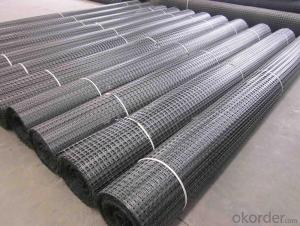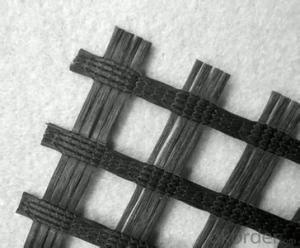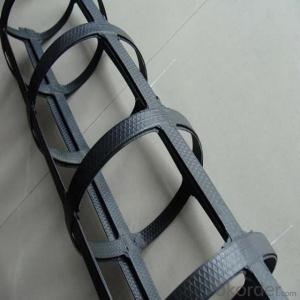Tenax Uniaxial Geogrids for Asphalt Pavement Road Consolidation
- Loading Port:
- Shanghai
- Payment Terms:
- TT OR LC
- Min Order Qty:
- 10000 m²
- Supply Capability:
- 1000000 m²/month
OKorder Service Pledge
OKorder Financial Service
You Might Also Like
Introduction :
CMAX fibergalss geogrid is based on fiberglass woven cloth coated with modifiedd bitumen or PVC,it was developed to address the problem of pavement cracking on highways,roads and runways,driven by a need to reduce cost for infrastructure maintenance and repair.
It is characterized by high tensile strength in axial and lateral directions,low stretch rate,alkali-resistance,low temperature-resistance,as well as convenience in construction and low price. It can be used on pitch pavement to pitch pavement to prevent cracks and prolong prvement service life.It also can be used as a basal reinforcement material for hillsides,reservoirs,harbors,ports,water channels,seawalls,etc.
Performance :
High strength,high modulus and low temperatures resistance.
Applications :
Reinforcement for road pavement
reinforecement for railway basement
Reinforcement for Tunnel
Reinforcement for Slope
Reinforcement for embankment
Specifications :
| Tensile Strength(KN) | Warp | >30 | >50 | >60 | >80 | >100 | >120 | >150 | >200 |
| Weft | >30 | >50 | >60 | >80 | >100 | >120 | >150 | >200 | |
| Elongation(%) | <4 | <4 | <4 | <4 | <4 | <4 | <4 | <4 | |
| Mesh Size (mm) | 25.4*25.4 | 25.4*25.4 | 25.4*25.4 | 25.4*25.4 | 25.4*25.4 | 25.4*25.4 | 25.4*25.4 | 25.4*25.4 | |
| Width(m) | 1-6 | 1-6 | 1-6 | 1-6 | 1-6 | 1-6 | 1-6 | 1-6 | |
| Length(m) | 50-300 | 50-300 | 50-300 | 50-300 | 50-300 | 50-300 | 50-300 | 50-300 | |
| Temperaturent Resista | -100~280 | -100~280 | -100~280 | -100~280 | -100~280 | -100~280 | -100~280 | -100~280 | |
| Resin Content(%) | 18~20 | 18~20 | 18~20 | 18~20 | 18~20 | 18~20 | 18~20 | 18~20 | |
| Glue Tpe | Bitumen PVC SBR soakage | Bitumen PVC SBR soakage | Bitumen PVC SBR soakage | Bitumen PVC SBR soakage | Bitumen PVC SBR soakage | Bitumen PVC SBR soakage | Bitumen PVC SBR soakage | Bitumen PVC SBR soakage | |



Remark: we are very large fortune 500 enterprise with more than 20branches in worldwide, and have almost ten years export experience in geosynthetic field. We have kunlun bank account and have many Iran geosynthetics customers.So if any question or support, please just feel free to contact me at any time.
- Q: Can geogrids be used in underground mining operations?
- Yes, geogrids can be used in underground mining operations. Geogrids are commonly employed in underground mining to provide reinforcement and stabilization to the surrounding rock and soil. They can help prevent slope failures, control ground movement, and enhance the overall safety and efficiency of mining operations.
- Q: Can geogrids be used in retaining walls for industrial facilities?
- Yes, geogrids can be used in retaining walls for industrial facilities. Geogrids provide reinforcement and stability to the soil, increasing the overall strength and durability of the retaining wall. This makes them an ideal choice for industrial facilities where there may be heavy loads or high lateral pressures. Additionally, geogrids can help reduce construction costs and increase the lifespan of the retaining wall.
- Q: Are geogrids suitable for use in green roof systems?
- Yes, geogrids are suitable for use in green roof systems. They provide structural support and reinforcement for the soil and vegetation layers, helping to prevent soil erosion and improve the overall stability and longevity of the green roof system. Geogrids also aid in distributing the load and reducing stress on the roof structure.
- Q: What are the design considerations for geogrid-reinforced embankments?
- Some key design considerations for geogrid-reinforced embankments include the selection of appropriate geogrid material, determining the required strength and stiffness of the geogrid, considering the effects of construction and installation techniques on the performance of the reinforcement, assessing the soil properties and slope stability of the embankment, and ensuring proper connection and interaction between the geogrid and the embankment materials. Additionally, factors such as long-term durability, potential for differential settlement, and environmental considerations should also be taken into account during the design process.
- Q: Can geogrids be used in bridge abutment reinforcement?
- Yes, geogrids can be used in bridge abutment reinforcement. Geogrids are commonly used in civil engineering for soil stabilization and reinforcement. They can provide additional strength and stability to bridge abutments by improving the load-bearing capacity of the soil and preventing settlement or lateral movement.
- Q: What is the effect of installation spacing on geogrid behavior?
- The effect of installation spacing on geogrid behavior is that it can impact the overall stability and strength of the geogrid system. Proper spacing ensures that the geogrids are installed at the correct intervals, allowing them to distribute the load evenly and provide effective reinforcement. Incorrect spacing can lead to inadequate reinforcement, reduced performance, and potential failure of the geogrid system.
- Q: Can geogrids be used in road widening projects?
- Yes, geogrids can be used in road widening projects. Geogrids are commonly used in road construction as they provide reinforcement and stability to the soil, helping to prevent soil movement and settlement. When widening a road, geogrids can be installed to improve the strength and load-bearing capacity of the soil, ensuring the stability and durability of the widened road.
- Q: Are geogrids suitable for erosion control?
- Yes, geogrids are suitable for erosion control. They are commonly used in various erosion control applications such as slope stabilization, retaining walls, and embankments. Geogrids provide reinforcement to the soil, preventing erosion and maintaining the integrity of the surface.
- Q: How do geogrids improve the performance of reinforced slopes?
- Geogrids improve the performance of reinforced slopes by providing additional strength and stability to the soil. They are placed within the soil layers and act as a reinforcement element, distributing the loads more evenly and reducing soil movement. This helps to prevent slope failure, increase the overall bearing capacity, and enhance the long-term durability of the slope.
- Q: Can geogrids be used in mechanically stabilized earth walls?
- Yes, geogrids can be used in mechanically stabilized earth walls. Geogrids are commonly used as reinforcements in mechanically stabilized earth walls to improve their stability and strength. They effectively distribute the forces within the soil and reduce potential wall failure.
Send your message to us
Tenax Uniaxial Geogrids for Asphalt Pavement Road Consolidation
- Loading Port:
- Shanghai
- Payment Terms:
- TT OR LC
- Min Order Qty:
- 10000 m²
- Supply Capability:
- 1000000 m²/month
OKorder Service Pledge
OKorder Financial Service
Similar products
Hot products
Hot Searches
Related keywords






























